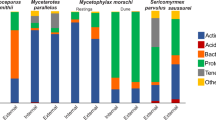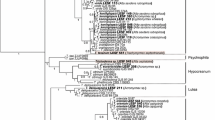Abstract
Fungus-growing ants and their fungal cultivar form a highly evolved mutualism that is negatively affected by the specialized parasitic fungus Escovopsis. Filamentous Pseudonocardia bacteria occurring on the cuticle of attine ants have been proposed to form a mutualistic interaction with these ants in which they are vertically transmitted (i.e. from parent to offspring colonies). Given a strictly vertical transmission of Pseudonocardia, the evolutionary theory predicts a reduced genetic variability of symbionts among ant lineages. The aim of this study was to verify whether actinomycetes, which occur on Acromyrmex octospinosus leaf-cutting ants, meet this expectation by comparing their genotypic variability with restriction fragment length polymorphisms. Multiple actinomycete strains could be isolated from both individual ant workers and colonies (one to seven strains per colony). The colony specificity of actinomycete communities was high: Only 15% of all strains were isolated from more than one colony, and just 5% were present in both populations investigated. Partial sequencing of 16S ribosomal deoxyribonucleic acid of two of the isolated strains assigned both of them to the genus Streptomyces. Actinomycetes could also be isolated from workers of the two non-attine ant species Myrmica rugulosa and Lasius flavus. Sixty-two percent of the strains derived from attine ants and 80% of the strains isolated from non-attine ants inhibited the growth of Escovopsis. Our data suggest that the association between attine ants and their actinomycete symbionts is less specific then previously thought. Soil-dwelling actinomycetes may have been dynamically recruited from the environment (horizontal transmission), probably reflecting an adaptation to a diverse community of microbial pathogens.


Similar content being viewed by others
References
Bass M, Cherrett JM (1994) The role of leaf-cutting ant workers (Hymenoptera: Formicidae) in fungus garden maintenance. Ecol Entomol 19:215–220
Bidet P, Lalande V, Salauze B, Burghoffer B, Avesani V, Delmee M, Rossier A, Barbut F, Petit JC (2000) Comparison of PCR-ribotyping, arbitrarily primed PCR, and pulsed-field gel electrophoresis for typing Clostridium difficile. J Clin Microbiol 38:2484–2487
Bot ANM, Rehner SA, Boomsma JJ (2001) Partial incompatibility between ants and symbiotic fungi in two sympatric species of Acromyrmex leaf-cutting ants. Evolution 55:1980–1991
Boucher DH (1988) The biology of mutualism: ecology and evolution. Oxford Univ. Press, New York
Cafaro MJ, Currie CR (2005) Phylogenetic analysis of mutualistic filamentous bacteria associated with fungus-growing ants. Can J Microbiol 51:441–446
Chapela IH, Rehner SA, Schultz TR, Mueller UG (1994) Evolutionary history of the symbiosis between fungus-growing ants and their fungi. Science 266:1691–1697
Currie CR, Mueller UG, Malloch D (1999a) The agricultural pathology of ant fungus gardens. Proc Natl Acad Sci USA 96:7998–8002
Currie CR, Scott JA, Summerbell RC, Malloch D (1999b) Fungus-growing ants use antibiotic-producing bacteria to control garden parasites. Nature 398:701–704
Currie CR, Scott JA, Summerbell RC, Malloch D (2003) Corrigendum: fungus-growing ants use antibiotic-producing bacteria to control garden parasites. Nature 423:461–461
Currie CR, Poulsen M, Mendenhall J, Boomsma JJ, Billen J (2006) Coevolved crypts and exocrine glands support mutualistic bacteria in fungus-growing ants. Science 311:81–83
Douglas AE (1994) Symbiotic interactions. Oxford Univ. Press, New York
Douglas AE (1995) The ecology of symbiotic microorganisms. Adv Ecol Res 26:69–103
Farish DJ (1972) Evolutionary implications of qualitative variation in grooming behavior of Hymenoptera (Insecta). Anim Behav 20:662–676
Fernandez C, Szabó IM (1978) Composition and properties of the actinomycete flora in a ferralitic tropical soil (oxisol)–sugar cane ecological system. Zentralbl Bakteriol Naturwiss 133:34–44
Frank SA (1997) Models of symbiosis. Am Nat 150:S80–S99
Frank SA (2003) Perspective: repression of competition and the evolution of cooperation. Evolution 57:693–705
Goodfellow M, Cross T (1984) The biology of actinomycetes. Academic, London
Gotelli NJ, Colwell RK (2001) Quantifying biodiversity: procedures and pitfalls in the measurement and comparison of species richness. Ecol Lett 4:379–391
Hamilton WD, May RM (1977) Dispersal in stable habitats. Nature 269:578–581
Hopwood DA, Bibb MJ, Chater KF, Kieser T, Bruton CJ, Kieser HM, Lydiate DJ, Smith CP, Ward JM, Schrempf H (1985) Genetic manipulation of streptomyces. A laboratory manual. John Innes Foundation, Norwich
Hughes WOH, Thomsen L, Eilenberg J, Boomsma JJ (2004) Diversity of entomopathogenic fungi near leaf-cutting ant nests in a neotropical forest, with particular reference to Metarhizium anisopliae var. anisopliae. J Invertebr Pathol 85:46–53
Kieser T, Mervyn JB, Buttner MJ, Chater KF, Hopwood DA (2000) General introduction to actinomycete biology. In: Kieser T, Mervyn JB, Buttner MJ, Chater KF, Hopwood DA (eds) Practical Streptomyces genetics. The John Innes Foundation, Norwich, pp 1–41
Lee JY, Hwang BK (2002) Diversity of antifungal actinomycetes in various vegetative soils of Korea. Can J Microbiol 48:407–417
Maniatis T, Fritsch EF, Sambrook J (1989) Molecular Cloning—a laboratory manual. Cold Spring Harbor Laboratory, New York
Martin MM (1970) The biochemical basis of the fungus–attine ant symbiosis. Science 169:16–20
Maschwitz U (1974) Comparative studies on the function of the metapleural gland in ants. Oecologia 16:303–310
Mühlenberg M (1993) Freilandökologie. Quelle and Meyer, Heidelberg
North RD, Jackson CW, Howse PE (1997) Evolutionary aspects of ant-fungus interactions in leaf-cutting ants. Trends Ecol Evol 12:386–389
Pernodet JL, Boccard F, Alegre MT, Gagnat J, Guerineau M (1989) Organization and nucleotide sequence analysis of a ribosomal RNO gene cluster from Streptomyces ambofaciens. Gene 79:33–46
Poulsen M, Boomsma JJ (2005) Mutualistic fungi control crop diversity in fungus-growing ants. Science 307:741–744
Poulsen M, Currie CR (2006) Complexity of insect–fungal associations: exploring the influence of microorganisms on attine ant–fungus symbiosis. In: Bourtzis K, Miller TA (eds) Insect symbiosis, vol. 2. CRC, Boca Raton, FL, pp 57–77
Poulsen M, Bot ANM, Nielsen MG, Boomsma JJ (2002) Experimental evidence for the costs and hygienic significance of the antibiotic metapleural gland secretion in leaf-cutting ants. Behav Ecol Sociobiol 52:151–157
Poulsen M, Cafaro M, Boomsma JJ, Currie CR (2005) Specificity of the mutualistic association between actinomycete bacteria and two sympatric species of Acromyrmex leaf-cutting ants. Mol Ecol 14:3597–3604
Ranzoni FV (1968) Fungi isolated in culture from soils of the Sonoran desert. Mycologia 60:356–371
Redenbach M, Kieser HM, Denapaite D, Eichner A, Cullum J, Kinashi H, Hopwood DA (1996) A set of ordered cosmids and a detailed genetic and physical map for the 8 Mb Streptomyces coelicolor A3(2) chromosome. Mol Microbiol 21:77–96
Rodrigues CRR, Drozdowicz (1978) The occurrence of Actinomycetes in a Cerrado soil in Brazil. Rev Écol Biol Sol 15:459–473
Rodrigues A, Pagnocca FC, Bueno OC, Pfenning LH, Bacci M (2005) Assessment of microfungi in fungus gardens free of the leaf-cutting ant Atta sexdens rubropilosa (Hymenoptera: Formicidae). Sociobiology 46:329–334
Schmid-Hempel P (1998) Parasites in social insects. Princeton Univ. Press, Princeton
Smibert RM, Krieg NR (1994) Phenotypic characterization. In: Gerhardt P, Murray RG, Wood WA, Krieg NR (eds) Methods for general and molecular microbiology. American Society for Microbiology, Washington, DC, pp 611–654
Thompson JD, Gibson TJ, Plewniak F, Jeanmougin F, Higgins DG (1997) The Clustal X Windows interface: flexible strategies for multiple sequence alignment aided by quality analysis tools. Nucleic Acids Res 25:4876–4882
von Ihering H (1898) Die Anlage neuer Colonien und Pilzgärten bei Atta sexdens. Zool Anz 21:238–245
Waksman SA, Lechevalier HA (1962) The actinomycetes, vol 3. Antibiotics of actinomycetes. Williams and Wilkinson, Baltimore
Wang Y, Zhang ZS, Ruan JS, Wang YM, Ali SM (1999) Investigation of actinomycete diversity in the tropical rainforests of Singapore. J Ind Microbiol Biotechnol 23:178–187
Weber NA (1966) Fungus growing ants. Science 153:587–604
Wheeler WM (1910) Colonies of ants (Lasius neoniger Emery) infested with Laboulbenis formicarum Thaxter. Psyche 17:83–86
Wilkinson DM, Sherratt TN (2001) Horizontally acquired mutualisms, an unsolved problem in ecology? Oikos 92:377–384
Wirth R, Beyschlag W, Ryel R, Herz H, Hölldobler B (2003) The herbivory of leaf-cutting ants. A case study on Atta colombica in the tropical rainforest of Panama. Springer, Berlin
Acknowledgements
We thank Silvia Schmidt and Pascal Petronelli for invaluable help during fieldwork and Stefanie Bohnert for support in the laboratory. Constructive suggestions on the study and the manuscript by Anne Behrend, Hubert Herz, Michael Lakatos, Sandra Patiño, Silvia Schmidt, Dieter Spiteller and four anonymous referees are gratefully acknowledged. The Smithsonian Tropical Research Institute of the Republic of Panama assisted with the research and granted collecting permits. This work was supported by the European Large Scale Facility (‘Silvolab,’ French Guiana, no. DG/FJ/033/98) to Rainer Wirth. All experiments complied with the current laws in Germany, French Guiana and Panama.
Author information
Authors and Affiliations
Corresponding author
Rights and permissions
About this article
Cite this article
Kost, C., Lakatos, T., Böttcher, I. et al. Non-specific association between filamentous bacteria and fungus-growing ants. Naturwissenschaften 94, 821–828 (2007). https://doi.org/10.1007/s00114-007-0262-y
Received:
Revised:
Accepted:
Published:
Issue Date:
DOI: https://doi.org/10.1007/s00114-007-0262-y




